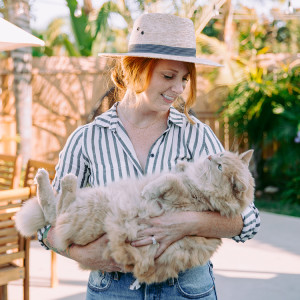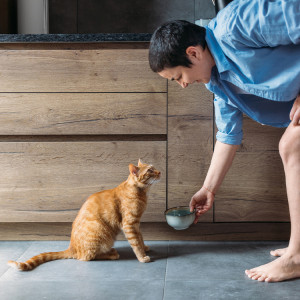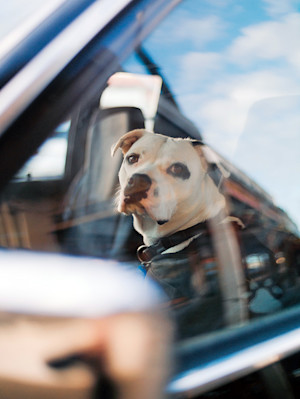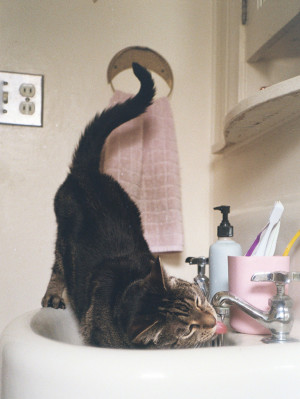Can Cats Sweat?
They definitely seem to get a good workout with that feather toy they’re obsessed with.

Share Article
In This Article:
Do Cats Sweat? Why Don’t Cats Sweat Like Humans? Why Don’t Cats Sweat to Cool Down? Heat Stroke In Cats
Unlike humans, who sweat to cool themselves, cats lack a sufficient number of sweat glands for sweating itself to prevent overheating. The sweat glands they do have are located mostly on the hairless area of their paw pads. Instead of sweating, cats use behavioral adaptations to keep cool.
Do cats sweat?
In people, sweat is produced by two types of glands in the skin - eccrine and apocrine glands. Although cats have both types of glandsopens in new tab, only the eccrine glands actually produce sweat. These are located exclusively on the hairless regions of a cat’s body, such as the paw pads and nose.

Why don’t cats sweat like humans?
Sweat works to keep us cool via evaporative coolingopens in new tab. In order for the water in the sweat produced on top of the skin to evaporate into the air, energy in the form of heat is required to convert the liquid water into a gas (vapor). This heat comes from the body so the evaporation effectively draws out excess heat.
For this process to be effective, it requires a large amount of surface area, which could only occur if there were enough glands on enough parts of the body. Given cats’ limited location of sweat glands (essentially the hairless paw pads), sweating cannot provide adequate cooling alone.
Why don’t cats sweat to cool down?
Given sweating would be ineffective as a primary cooling strategy for cats, our kitties have other means to maintain their normal body temperature, which ranges from 99 to 102 degrees Fahrenheit. Cats evolved in warm, desert climates so their normal behaviors reflect heat adaptations.
Cats are more tolerant of heat, but their cooling strategies are to use behavioral modification to prevent overheating in the first place, as their body is limited in its ability to manage excess heat physiologically.
Our pet cats are crepuscular, meaning they are most active at dawn and dusk when the temperatures are lower. During the heat of the day, felines tend to keep physical activity to a minimum and are more inclined toward napping. With warmer temperatures, they will seek cooler surfaces, shady areas, and adopt a more sprawled-out body posture to help release excess heat. They can also employ evaporative cooling on their bodies by licking their fur, drawing heat from the body as the saliva evaporates, similar to sweating.
Of course, if their body temperature rises, they can and will sweat from their paw pads. They can also sweat from their pads when nervous, such as during a trip to the vet when sweaty prints may be visible on the shiny exam table.
While dogs rely on panting as a primary cooling mechanism, this is not the case in cats. Cats can pant if overheated but this is more likely to occur during extreme stress (also potentially occurring at the vet!), high exertion, or some disease conditions like heart failure or respiratory disease.
Heat stroke in cats
Despite their desert origins, cats can still experience life threatening consequences to a sustained elevated body temperature, known as heat-related illnessopens in new tab or “heat stroke.” This is more common in dogsopens in new tab, mostly secondary to exertional heat stress from exercising too long or too intensely (usually in warmer temperatures).
Pet cats would be more likely to experience heat-related illness due to high environmental temperatures, as they are less likely to engage in outdoor exercise when it is hot. This means that for our exclusively indoor cats, we can usually control their risk of heat stroke by controlling their environments. Unfortunately, ever-increasing weather extremes due to climate change will likely make heat stroke prevention more challenging and require more diligence from pet parents.
Ways to prevent heat-related illness in cats can include:
Temperature: Air conditioning, shade with curtains, and fans are the first-lines of defense for us and our indoor cats during high temperatures. Open windows for ventilation can help, but window precautions are a must. Ensure all open windows have secure screens to prevent cats from escaping or falling from height.
Hydration: Ensure there is fresh water in multiple locations in the home. Since cats are less active when hot or if they have mobility issues, having water close to them can help prevent dehydration. Increasing wet food in the diet (as long as they like it!) can be a helpful way to increase hydration in our cats when temperatures rise. One should be careful with pools, and bathtubs or sinks full of water as these are drowning risks.
Cat proofing: Avoid accidental confinement in a space that could cause your kitty to overheat, such as unventilated rooms, containers, and driers.
Avoid traveling with or taking your cat outside during hot, humid weather. This goes without saying: Never leave your pet cat in a hot car.
If kitties are indoor/outdooropens in new tab or you are caring for community cats, provide shelters with shade, easy access to fresh water, and frequent checks-in. Prevention of heat-related illness is a good reason to consider an indoor-only lifestyle for cats when possible.
How do we identify heat strokeopens in new tab in cats? As with most conditions, initial signs may be subtle and can mimic other conditions. If exposed to elevated temperatures leading to heat-related illness, they may show the following. If in doubt, the safest thing is always to seek veterinary attention.
Signs of heat stroke in cats can include:
Excessive panting
Drooling
Vomiting or diarrhea
Elevated heart rate
Lethargy or agitation
Muscle tremors
In severe cases, collapse, neurological signs such as incoordination, seizure, and unconsciousness
Certain characteristics could make a cat more susceptible to heat-related illness:
Breeds such as short-faced (brachycephalic) cats like the Persian or exotic shorthair
Long coat length or darker color
Older age
Health conditions such as lung or heart disease, metabolic conditions such as hyperthyroidism, kidney disease, and mobility conditions
What do you do if you suspect heat related illness in your cat? Heat stroke is a true emergency and you should seek veterinary attention immediately. The animal should be moved to cooler temperatures and can be placed on top of a cool, wet towel while on the way to the vet.
FAQs (People also ask):
Why does it feel like my cat is sweating?
You may detect a clammy moisture on your cat’s paw pads when they are nervous or warm and that is in fact sweat. If you feel wetness on the fur itself, that is likely from saliva due to grooming. Or your cat had contact with a wet substance in their environment.
Why does my cat overheat so easily?
You should discuss with your vet what you perceive as overheating. If your cat is indoor only with adequate temperature control such as air conditioning and she has easy access to fresh water, there may be something going on with her health.
Certain signs often associated with overheating like panting could indicate a health condition that needs to be addressed. If your cat truly does seem more susceptible to being overheated, she may need a health work up for a metabolic condition, a haircut, or a weight-loss plan. Ultimately, best to check with the vet!
What are cat heat stroke symptoms?
These can be subtle and are not specific to just heat-related illness or heat stroke. Excessive panting, drooling, vomiting, diarrhea, lethargy, agitation, or, in more severe cases, neurological signs and collapse can be seen. If you are at all concerned your pet is experiencing heat stroke, move them to a cooler environment and seek veterinary attention immediately.
References:
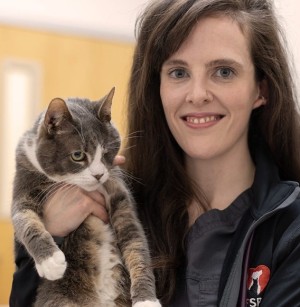
Melanie Glass
Melanie Glass is a veterinarian practicing in New York City, currently working in shelters and private practice. She is particularly passionate about feline medicine, dentistry, surgery, and animal welfare. When not working, she balances training for road races in Central Park, exploring with city with friends, and quality time reading at home with her cats, Christina Crawford, Rosalind Franklin, and Starfish.
Related articles
![Young woman smiles while standing outside wearing a sunhat and holding up her big fluffy cat.]()
Keeping Cats Cool in Summer: Essential Safety Tips for Your Feline Friends
And other summer safety tips.
![Australian shepherd panting with tongue out, walking ahead of owners.]()
How to Keep Your Pets Safe During Extreme Heat Waves
As scorching, long-lasting temperatures become the new normal, here’s how to help keep your pets cool and healthy.
![Person with short hair putting water bowl on floor for cat]()
How to Get a Cat to Drink Water
Their desert-dwelling roots might resist hydration, but these tricks can help.
![Pitbull sitting in a car alone on a hot, summer day.]()
It’s Illegal to Leave Your Pet in a Hot Car In These States
As the temps rise, it becomes extremely risky for your pet’s health.
![Tabby cat leaning into a porcelain sink, tail curled in the air, as it sticks its tongue out to drink water from the faucet.]()
Why Is My Cat So Damn Thirsty?
No, not like that. They’re literally drinking a lot of water. Here’s when you should be worried.
![cat with cone after vet visit]()
How Often Should You Take Your Cat to the Vet?
Get thy cat to a vet, even if it’s a struggle to get them out the door.
